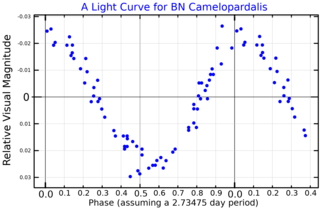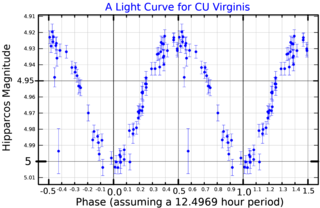
Chi Serpentis is a solitary star in the Serpens Caput section of the equatorial constellation Serpens. Based upon an annual parallax shift of 14.84 mas as seen from Earth, it is located around 222 light years from the Sun. The star is bright enough to be faintly visible to the naked eye, having an apparent visual magnitude of +5.30.

28 Cancri is a star system in the zodiac constellation of Cancer. It is a variable star with the designation CX Cancri, and is close to the lower limit of visibility with the naked eye, having a mean apparent visual magnitude of 6.05. The annual parallax shift seen from Earth's orbit is 8.5 mas, which provides a distance estimate of about 384 light years. It is moving away from the Sun with a radial velocity of around +9 km/s.

12 Canis Majoris is a variable star located about 707 light years away from the Sun in the southern constellation of Canis Major. It has the variable star designation HK Canis Majoris; 12 Canis Majoris is the Flamsteed designation. This body is just barely visible to the naked eye as a dim, blue-white hued star with a baseline apparent visual magnitude of +6.07. It is moving away from the Earth with a heliocentric radial velocity of +16 km/s. This is the brightest star in the vicinity of the open cluster NGC 2287, although it is probably not a member based on its proper motion.

NO Apodis is a solitary, red hued variable star located in the southern circumpolar constellation Apus. It has an average apparent magnitude of 5.86, allowing it to be faintly seen with the naked eye. The object is relatively far at a distance of 790 light years but is drifting closer with a heliocentric radial velocity −18.3 km/s.
VZ Arietis is single, white-hued star in the northern zodiac constellation of Aries. Varying between magnitudes 5.82 and 5.89, the star can be seen with the naked eye in dark, unpolluted areas. Based upon an annual parallax shift of 5.8 mas, it is located 560 light years from the Sun. It is moving further away with a heliocentric radial velocity of +14 km/s. The star was formerly known as 16 Trianguli, but as the star is no longer in the constellation Triangulum, this designation has fallen out of use.

Beta Coronae Australis, Latinized from β Coronae Australis, is a solitary star located in the southern constellation Corona Australis. It is visible to the naked eye as a faint, orange-hued star with an apparent visual magnitude of 4.10. The star is located around 470 light years distant from the Sun based on parallax, and is drifting further away with a radial velocity of 2.7 km/s. At its current distance, Beta CrA's brightness is diminished by 0.29 magnitudes due to interstellar dust.

CQ Camelopardalis, abbreviated as CQ Cam, is a solitary variable star in the northern circumpolar constellation Camelopardalis. It has an apparent magnitude of 5.19, making it visible to the naked eye under ideal conditions. The object is relatively far at a distance of about 2,000 light years but is drifting closer with a heliocentric radial velocity of −22 km/s. It has a peculiar velocity of 21.8+2.1
−1.9 km/s, making it a runaway star.

BN Camelopardalis is a suspected astrometric binary in the northern circumpolar constellation of Camelopardalis. It appears as a variable star that is visible to the naked eye as a dim, white-hued point of light with an apparent visual magnitude that fluctuates around 5.49. The system is located at a distance of around 310 light years from the Sun based on parallax, and is drifting further away with a radial velocity of +9 km/s.

111 Tauri is a wide binary star system in the constellation Taurus. It is located at a distance of 48 light years from the Sun. Primary component A is a main sequence star with a stellar classification of F8V. The secondary component B is a K-type main sequence star. The primary is larger and more luminous than the Sun, with about 130% of the Sun's radius and 185% of the Sun's luminosity. The apparent magnitude of 5.0 indicates it is a faint star that can be viewed by the naked eye under good, dark-sky conditions.

Eta2 Coronae Australis, Latinized from η2 Coronae Australis, is a solitary star located in the southern constellation of Corona Australis. It is visible to the naked eye as a dim, blue-white hued star with an apparent visual magnitude of 5.59. Gaia DR3 parallax measurements imply a distance of 770 light years from the Solar System, but it is drifting closer with a radial velocity of −23 km/s. At its current distance Eta2 CrA's brightness is diminished by 0.27 magnitudes due to stellar extinction from interstellar dust and it has an absolute magnitude of −0.24.

CU Virginis is a single star in the equatorial constellation of Virgo. It has an apparent visual magnitude of 4.99, which is bright enough to be faintly visible to the naked eye. The distance to this star can be estimated from its annual parallax shift of 13.9 mas, yielding a separation of 234 light years.
4 Cygni is a binary star system in the northern constellation of Cygnus. It is a faintly visible to the naked eye with an apparent visual magnitude of 5.17. The distance to 4 Cygni, as determined from its annual parallax shift of 5.8 mas, is about 560 light years.

S Apodis, also known as HD 133444 is a variable star located in the southern circumpolar constellation Apus. It has an apparent magnitude ranging from 9.6 to 17, which is below the limit for naked eye visibility. The object is located relatively far at a distance of approximately 15,000 light years based on Gaia DR3 parallax measurements, but it is drifting closer with a heliocentric radial velocity of −75 km/s.

HD 137509 is a star in the southern constellation of Apus, positioned less than a degree from the northern constellation boundary with Triangulum Australe. It has the variable star designation of NN Apodis, or NN Aps for short, and ranges in brightness from an apparent visual magnitude of 6.86 down to 6.93 with a period of 4.4916 days. The star is located at a distance of approximately 647 light years from the Sun based on parallax, and is drifting further away with a radial velocity of +0.50 km/s.

Xi Phoenicis, Latinized from ξ Phoenicis, is a visual binary star system in the southern constellation of Phoenix. It is faintly visible to the naked eye, having an apparent visual magnitude of 5.70. Based upon an annual parallax shift of 14.61 mas as measured from Earth, it is located around 223 light years from the Sun. The system is moving away from the Sun with a radial velocity of about +10 km/s.
Theta Hydri, Latinized from θ Hydri, is the Bayer designation for a blue-white hued star in the southern constellation of Hydrus. It is faintly visible to the naked eye with an apparent visual magnitude of +5.53. Based upon an annual parallax shift of 6.50 mas as seen from Earth, is located approximately 502 light years from the Sun. At that distance, the visual magnitude of the star is diminished by an extinction of 0.10 due to interstellar dust. It is moving away from the Sun with a radial velocity of +12.3 km/s.

WZ Columbae, also known as HD 38170, is a solitary, bluish-white hued star located in the southern constellation Columba, the dove. It has an apparent magnitude of 5.28, allowing it to be faintly visible to the naked eye. Based on parallax measurements from the Gaia spacecraft, the object is about 365 light years distant. It appears to be receding from the Solar System, having a heliocentric radial velocity of 36.3 km/s.
HD 43899, also designated as HR 2263, is a solitary, orange hued star located in the southern constellation Columba, the dove. It has an apparent magnitude of 5.53, allowing it to be faintly visible to the naked eye. Based on parallax measurements from the Gaia spacecraft, the object is estimated to be 284 light years distant. It appears to be rapidly receding with a heliocentric radial velocity of 66.5 km/s. Eggen (1993) lists HD 43899 as an old disk star and its kinematics match with that of the ζ Herculis moving group.

PW Telescopii, also known as HD 183806 or simply PW Tel, is a solitary variable star located in the southern constellation Telescopium. It has an average apparent magnitude of 5.58, making it faintly visible to the naked eye. Based on parallax measurements from the Gaia satellite, the star is estimated to be 395 light years distant. It appears to be approaching the Solar System with a heliocentric radial velocity of −10 km/s. The value is somewhat constrained, having an uncertainty of 26%. At its current distance, PW Tel's brightness is diminished by 0.05 magnitudes due to interstellar dust.

V718 Coronae Australis is a solitary variable star located in the southern constellation Corona Australis. It is faintly visible to the naked eye as a red-hued point of light with an apparent magnitude of 5.43. Gaia DR3 parallax measurements imply a distance of 630 light years and it is currently receding with a heliocentric radial velocity of 28.5 km/s. At its current distance V718 CrA's brightness is diminished by 0.37 magnitudes due to interstellar dust and it has an absolute magnitude of −1.03.















